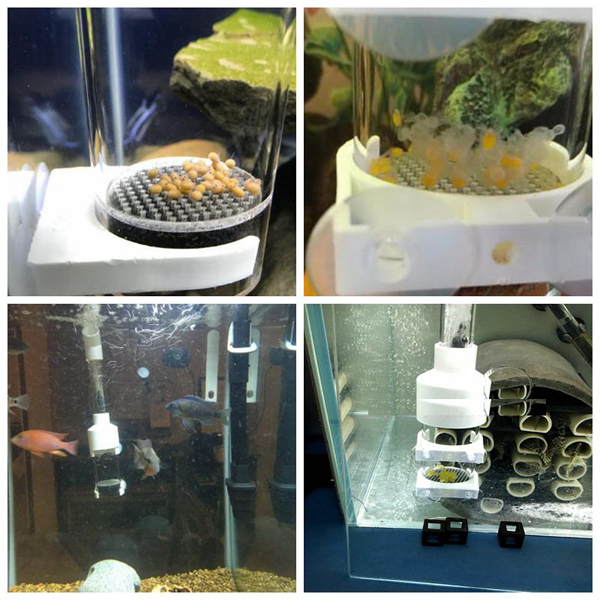Caring for Freshwater Angelfish Eggs
(2020年05月15日)https://www.senzeal.com/blog/caring-for-freshwater-angelfish-eggs-b0473.html
When it comes to freshwater fish breeding in the aquarium, the most difficult task may be taking care of your eggs to hatch after fish has the eggs. Once the eggs are laid, you may need to take the female fish out of the tank and grow the eggs into big fish. Raising angelfish eggs isn't as difficult as you might think -- you just need to keep a few precautions in mind to increase your chances of successfully breeding. The most important thing is to make sure your angelfish eggs hatch and the fry grows, so make sure they're well protected and well-fed. If you can complete both tasks, you will be rewarded with a healthy group of angelfish. In this process,you may use aquarium fish tank light to have a warm condition.
Breeding freshwater angelfish can be a rewarding experience but raising the eggs to maturity may be a challenge.
Basics of Breeding Angelfish
There are many different species of freshwater angelfish, ranging from black, white, and silver to bright yellow, orange, and red. These fish are attractive and are a popular addition to home aquariums. Part of the reason these fish are so popular, apart from their beautiful appearance, is that they are not particularly difficult to breed. A single spawning can result in hundreds of eggs, though many of them will not hatch. If you take a few precautions, however, you can raise a large number of angelfish eggs into adulthood. Breeding angelfish starts with setting up a proper breeding tank.
Your fish tank breeding net does not need to be carefully designed, all you need is the right water temperature, a pair of angelfish, a slate that angelfish can spawn. In the wild, angelfish like to lay their eggs on the broad leaves of the Amazon sword plant, but in the breeding tank, a slate with a 30-degree angle is also acceptable. Raising the temperature of your tank a few degrees, in addition to adding a little bit of water from another tank in which angelfish are successfully breeding, can help to encourage your angelfish. Once your fish have mated and spawned, you next need to focus on caring for the angelfish eggs.
Caring for Angelfish Eggs
There are many different kinds of angelfish, but all eggs can generally be raised in the same way. Once the eggs are placed on the slate, you can choose to take them out of the tank and keep them in a separate place or leave them in the tank for the fish's parents to care for. If you choose to raise the eggs separately from the parents then you need to place them in a large container of water from the tank and insert an airstone on a low setting to achieve water flow - you may also choose to treat the water with methylene blue to keep off fungus. If you want to raise your angelfish eggs in the tank with the parents then you will need to take different precautions.
Once spawning, angelfish will protect their eggs very much-they may attack other fish who get too close to them, even their mates. To avoid too many offensive issues, you can clear all other fish in the fish tank. Except for one or two mild-tempered species, they can prevent angelfish from attacking each other, but they do not threaten the eggs.
Angelfish also tend to eat their own eggs, so if you choose to leave your angelfish eggs in the same fish tank as their parents, you need to pay close attention to the parents. Other fish may also be drawn to the eggs - plecostumus are particularly known to raid the eggs during the night when the adult angelfish are not keeping a close watch.
Caring for Angelfish Fry
After a few days, the angel fish's eggs will germinate and will begin to wriggle while still adhering to the slate. In a few days, the eggs will absorb the yolk sac, separate from the slate, and swim around in the water tank by themselves. At this stage, the young will start to look for their own food. If the young and their parents are left in the tank, adult angelfish will have more difficult stages to protect them. In order to raise a majority of the fry to maturity, it is essential to keep them fed. Commercial fry food is not an adequate diet for angelfish fry - in order for the fry to thrive, they must be fed a diet of infusoria or newly hatched brine shrimp at least once a day (several times a day for best results).
Another important aspect of rearing angelfish fry involves protecting them from hungry fish and other potential dangers. When the fry hatch and begin to grow, removing any other fish from the fish tank can greatly increase the survival rate of most fry. If you don't want to remove other fish, be sure to provide hidden areas for fry, such as large areas, and avoid using strong filters because fry can be easily sucked into the filter. Some aquarium enthusiasts use the mesh at the bottom of the tank to allow fry to swim out of reach of adult fish.
By following these tips you can successfully raise your angelfish eggs into healthy adults. By completing these tips closely, you can successfully develop your angelfish eggs into healthy adult fish. When raising angelfish fry, the most important thing is to feed the fish regularly to prevent the fry from being eaten. Most fry can survive up to 12 hours without food but should be fed four to five times a day for optimum results. With frequent feeding, your fry will grow faster and become more self-sufficient. Over time, you'll have plenty of beautiful adult angelfish to enjoy.
Looking for more aquarium accessories online? Go to our category pages for more information.

- このできごとのURL:



コメント